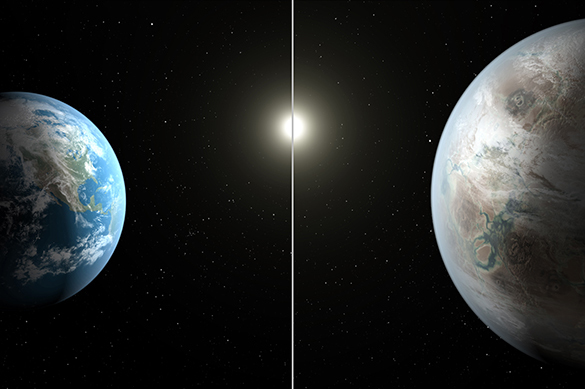How long will the Earth live?
Even if life on this planet does not cease as a result of a global climate disaster, a nuclear war or a collision with an asteroid, sooner or later the world must end. In 1.75 billion years, the Earth could become uninhabitable under the influence of cosmic processes, experts believe.

A star of an average mass similar to the Sun is in a state of the hydrogen cycle for most of its life. When it burns its entire stock of hydrogen fuel and hydrogen in its core turns into helium, thermonuclear burning of hydrogen continues in the periphery. At this time, the luminosity of the object increases, its outer layers expand and the surface temperature goes down. The size of the star increases by about 100 times, and it becomes a red giant. It stays in this phase significantly less time than in the hydrogen stage - a few millions of years.
Finally, the resulting helium nucleus cannot withstand its own weight and begins to shrink. If the object is sufficiently massive, the increase in temperature may cause transformation of helium into heavier elements, sequentially to carbon, oxygen, silicon and iron. For the stars of average weight this period may last billions of years. For our planet hour "X" may come in a time period between 1.75 to 3.25 billion years. By the time the Sun will warm up and increase in volume. The Earth will subsequently fall out of the so-called habitable zone.
It is believed that a mandatory feature of a habitable zone is water. This means that the planet must be placed at a distance from its mother star that would ensure that the water is present in liquid form. By the indicated time Earth's oceans will evaporate. But even before that the conditions necessary for the development of complex life forms, including the human race, will disappear.
At the same time, a planet's location in the habitable zone does not mean that complex life forms will be found there. On planet Earth, first simplest cells appeared about 4 - 3.8 billion years ago, whereas insects only 450 - 410 million years ago, dinosaurs - 225 million years, flowering plants - 140 - 135 million years ago, and humans in their present form only 400 - 225 thousand years ago. That is, the emergence of intelligent life has required almost 75 percent of the time allotted to the Earth. Scientists believe that if a planet stayed in the habitable zone for no more than a million years, we should not be looking for living organisms there.
The development of life is influenced by other factors. For example, planets may be too large or, on the contrary, too small; the presence of a mixture of atmospheric gases on them may be unfavorable for life; and finally, there may be no atmosphere at all. Experts say that if we were to arbitrarily take any planet from the habitable zone, it would be far more likely that there is no life on it, at least in the usual forms.
A team of researchers from the University of East Anglia (UK) led by Andrew Rushby decided to base their calculations on the amount of time a planet spends in the habitable zone. They took into account the current understanding of the evolution of stars involved in the so-called main sequence. The more massive the star is, the shorter is its life cycle.
Toward the end of their existence, planets become hotter and grow in size. As a result, the zone of habitability shifts. On planets that are potentially habitable it gets too hot, and the life is dying, but there are favorable conditions on planets whose surface was a cold and dry desert.
Rushby and his colleagues "tested" the model they created on Earth, Mars and other planets of the seven different star systems. It turned out that the Earth can survive for 7.79 billion years (4.5 billion have already passed), and it will spend 6.29 billion years in the habitable zone. Interestingly, for the rest of the planets the age range was very large. For example, Kepler-22 is to live for 4.3-6.1 billion years, while Gliese 581 d will live 42.4-54.72 billion years. That is, the latter will survive with favorable conditions for life ten times longer than our solar system.
Sooner or later we will certainly face the issue of resettlement of humans to other celestial bodies. The most realistic option today is Mars. First, it is the closest planet to us, and second, it will remain in the habitability zone for another six billion years. As for the next closest to the earth planet suitable for life, according to experts, it should be sought within ten light years away from the Earth. However, so far it has not been discovered.
Irina Shlionskaya
Pravda.Ru
Subscribe to Pravda.Ru Telegram channel, Facebook, RSS!

